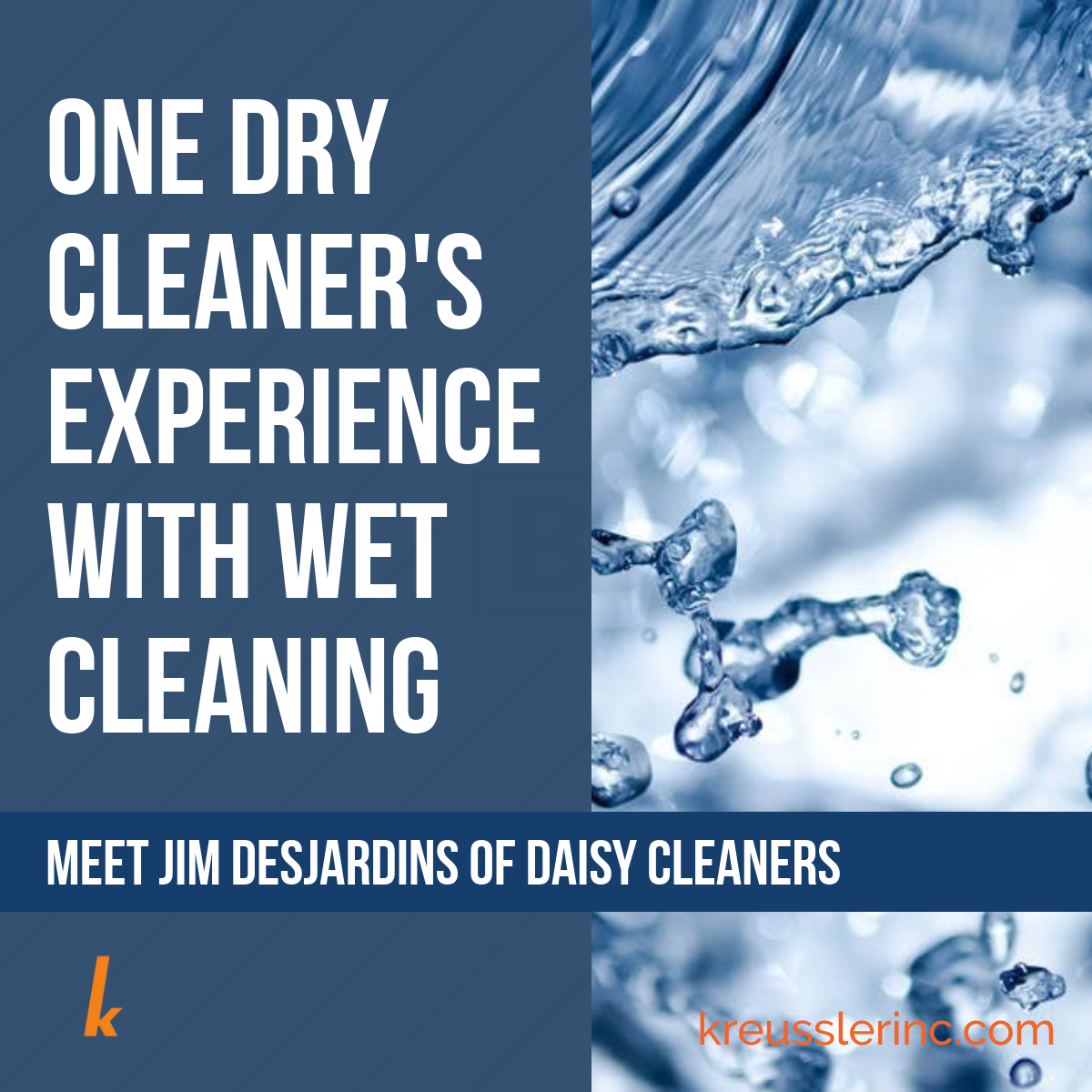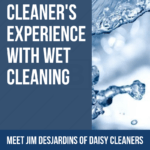Each dry cleaning operation is unique and is run a little differently. We’d like to share an interview with Jim Desjardins of Daisy Cleaners in Salem, New Hampshire given by Richard Fitzpatrick about wet cleaning.
Richard Fitzpatrick: Hello Jim! Thank you for your time for this interview. You’re a second generation dry cleaner, your father started Daisy, correct?
Jim Desjardins: He didn’t actually start it but he purchased it in 1963, and I’m honestly not sure, it had only been open for a few years before that. I don’t believe it was a lot earlier than that. My dad bought it in ’63 and we worked together in the ’80s for possibly ten years, and then he passed away and I took the business over from there.
Richard Fitzpatrick: You’ve been running it pretty much solo, you and your wife for the last 30 years, 35 years?
Jim Desjardins: Yeah, I’ve actually been working in the store full time since about 1984.
Richard Fitzpatrick: Okay, that’s a lifelong experience. When you started and going through the 80’s, the idea of wet cleaning to you what was that?
Jim Desjardins: That was foreign. That was the wash, it was a washing machine.
Richard Fitzpatrick: So buckets and soaking and that kind of stuff, right?
Jim Desjardins: Yeah, I mean we didn’t do a whole lot of it, and if we did we didn’t have the chemistry behind it since we were really just set up to launder shirts. If you launder even the easy-care items, in a traditional shirt laundry wash program, they don’t come out that great. It would really beat the hell out of them.
Richard Fitzpatrick: What made you decide to get more into wet cleaning?
Jim Desjardins: There were several factors. One, I was tired of customers’ clothes smelling like B.O. I mean I don’t care what kind of dry cleaning fluid I’ve used and I’ve used Perk, I’ve used Green Earth, I’ve used K4, frankly I’ve used all of them. That’s something that requires water to get out of the garments. I have a very sensitive nose and I knew that I needed to wet clean those items to get it out.
Jim Desjardins: The second thing that I came up with was I knew that the majority of the stains that people got on their clothes were water soluble. I would say there’s a small percentage of them that actually come in with oil stains on them. I know from 35 years of experience, I can honestly tell you that I don’t look at every single care instruction. Because of my knowledge, I can tell how to process something just by the hand feel of the garments, but I would say that easily, without any hesitation, 25% of the clothes that are coming over the counter could be wet-cleaned. And most likely have some type of washing care labels.
Jim Desjardins: I’m talking about dry clean items, not cotton shirts.
Richard Fitzpatrick: Do you make a conscious decision to simply move those garments into wet-cleaning or do you still look at them and decide, a la carte, this one’s going to go wet, this one’s going to go dry?
Jim Desjardins: As I’m separating my color loads, I will start separating out those items individually, more prominently in the summer-time. We’re doing a lot more golf shirts in summer, and clearly, again a perspiration issue with those things ’cause they’re out in the sun and can you clean it in dry clean solvent? You can, but I don’t think it cleans as well as the wet-cleaning. So I do, on an individual basis as I’m going through the loads in the morning, setting stuff up, make loads for regular dry cleaning, right now we’re running a sweater sale, bring in two get one cleaned free. 99% of all of the cashmere sweaters, any of those things that most people would really try to stay away from getting wet, they go wet cleaning. They come out the best. They come out with no static electricity. I know, if I’m processing sweaters at a pressing station, immediately if it went through dry cleaning or not. You can almost feel that little granule stuff that is stuck in the fibers of the sweaters and with wet cleaning, it’s a non-issue. They smell better, no static electricity, and just easier to process.
Richard Fitzpatrick: Now you’re not concerned about shrinkage with that type of fabric?
Jim Desjardins: No, I currently do not have a conductivity controlled dryer, which is something that wet cleaners would use more frequently to handle those items. It closely controls the drying so that you’re not getting into trouble. But, again, having the experience – typically we will take even those items and throw them into a conventional laundry dryer at a low temperature for 13 minutes, and all that does is just get some of the excess moisture out. Then we put them on form finisher quickly and then hang them up to finish air drying.
Richard Fitzpatrick: So you don’t necessarily need to go out and make substantial investments in equipment, you seem to be really good at getting the most out of what you got in the plant. Do you think that’s a good path for a lot of cleaners?
Jim Desjardins: I don’t know how true that statement is, specifically I think that’s the biggest misconception in the dry cleaning industry, for people who don’t know about wet cleaning, the importance of the actual washing machine, probably more than anything, the wet cleaning machine. At Daisy when we installing new shirt laundering equipment, we made the decision to spend the extra three or four thousand dollars to get the machine that I could both use as a shirt laundry machine and could double as a wet cleaning machine. It did very well at controlling agitation, temperature, etc.
It’s kind of a catch-22. Can you do a lot of wet cleaning in a conventional washer? Yes, you can. But, you know, with the help of Kreussler and the chemistry that we have, everything from comforters not being over-agitated, to my wedding gown work and we probably process over $20,000 a year worth of wedding gowns in my small, little, 1800 square foot store. This morning I cleaned a wedding gown in my wet cleaning machine, I cleaned a pair of Ugg boots, I cleaned a suede purse in my wet cleaning machine. All this morning, so I think what message I might bring across to other cleaners that are willing to learn new things is that the added capability that you have with the proper wet cleaning machine most likely will pay for the equipment investment itself.
Richard Fitzpatrick: So invest, but invest wisely. Invest in a good microprocessor, controlled washer/extractor, and then as you can go, maybe some tensioning equipment or humidity controlled dryer. Is that it?
Jim Desjardins: Right, right. That being said I’ve been fortunate to be able to get some tensioning equipment in my store so I do have the tensioning pants topper and form finisher and that does make a big deal. I’ll give you a quick for instance. We wet clean all of our wool coats. Again, people are like, “Oh my God! You wet clean your cashmere coats!” Yeah, I do. And they’re so much easier to process when I wet clean them because there’s no static electricity and there’s no water-soluble stuff in the fibers of the clothes, no salt stains down at the bottom. As you know we card most of our wool coats so it actually makes it easier during the carding process because you don’t have the fibers blowing around in the air because they’re wet.
And then we put them on the form finisher and we steam them out, and again I’ll either air dry them or if it’s a special I need to have that day, I’ll just put it on the form finisher and we can dry it probably in 4-5 minutes, the garment’s dry.
Richard Fitzpatrick: Have you been able to measure an economic benefit to the company, by doing more in water than when you just had solvents? Whether it’s increased productivity or just a better quality piece going out to the end user?
Jim Desjardins: I’m not the world’s best measurer when it comes to stuff, but I am very particular about the quality of the product that we put out. So what I would say is that we do have the ability to produce more work because we have our staff running the laundered shirts in the evening, which opens up those machines to be used for other things during the day. So again, this morning, they had already run shirts last night so I produced two comforters, I produced two sets of Ugg boots and a pocketbook. The Ugg boots, pocketbooks, it was $150 worth of stuff, not including comforters, that I was able to process this morning and that’s work that I couldn’t get if I didn’t have the wet cleaning capabilities.
Jim Desjardins: I just think that having the relationship with your chemistry company is so important because, for instance, we were dry cleaning all of our wedding gowns and now, I would say that we wet clean 98% of all of my wedding gowns. I used to hand scrub the whole thing, now it’s the chemistry magic show because I put the stuff in to soak in the wet cleaning machine in the evening before I leave and when I come in in the morning I run a delicate program that Kreussler set up for me, and 99% of the time I don’t have to touch them. I don’t want to say free money, but I’m not working really hard to get it and it’s enabled me to have this reputation of being the go-to guy. I have people that come from other states around us, several states, for me to process their wedding gowns.
Jim Desjardins: We’re in the process of relocating the plant around the corner. I’m hoping to purchase one dry cleaning machine instead of two and increase my wet cleaning capability.
Richard Fitzpatrick: You’re making a conscious decision that moving more of your production through water is probably the right way to go.
Jim Desjardins: Definitely.
Thank you, Jim, for your time!
You can find Daisy Cleaners on Facebook and their website.


